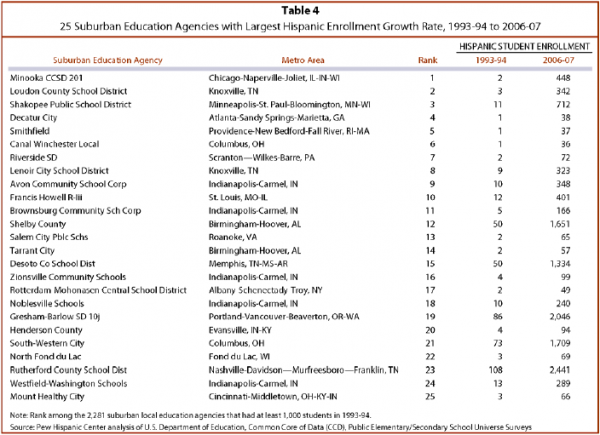The analysis above examined student enrollments in the entire suburban sector of public education. However, every individual suburban school district experienced minority student growth slightly differently. The average suburban school district experienced large growth in its minority student enrollment. Among the 2,281 suburban school districts that were in operation in both 1993-94 and 2006-07 and that had at least 1,000 students in 1993-94, minority student enrollment of the average district grew by 150% (Figure 5). White enrollment in the average suburban district did not grow over the 13-year period. The typical suburban district’s Hispanic enrollment nearly quadrupled. Its black student population more than tripled, and its Asian enrollment more than doubled. These very high minority student population increases partly reflect the extremely high growth among some unusual suburban districts. But half of the suburban districts (with at least 1,000 students in 1993-94) experienced minority student growth of at least 93%, or a near doubling of their minority student enrollment.
 As a result of the rapid growth in minority students and flat growth among white students, 287 of the nation’s 2,808 suburban school districts have become majority-minority school districts since 1993-94.
As a result of the rapid growth in minority students and flat growth among white students, 287 of the nation’s 2,808 suburban school districts have become majority-minority school districts since 1993-94.
Table 3 reports the 25 fastest-growing suburban school districts in terms of black enrollment. In Tables 3 to 5, growth is measured in terms of percentage growth in the student population. Very large growth rates are obtained because most of the school districts had very small minority student enrollments in 1993-94 (though they had at least 1,000 students in toto in 1993-94). Some suburban school districts experienced larger gains of minority students in absolute numbers, but because they had larger numbers in 1993-94, their percentage gains do not rank particularly high.
The vast majority (18) of the fastest-growing suburban districts in terms of black enrollment are in the Midwest. Almost a quarter of them are in Chicago’s suburbs. Districts in suburban Detroit and suburban Indianapolis have also experienced rapid growth in black enrollment.
The fastest-growing Hispanic (Table 4) and Asian (Table 5) suburban school districts are less concentrated in the Midwest and include some Southern school districts. Several school districts in suburban Knoxville, Memphis and Nashville experienced hyper-growth in their Hispanic student populations since 1993-94. Among Asian suburban students, numerous school districts in the Dallas-Fort Worth and Atlanta metro areas are among the 25 fastest-growing suburban school districts.

 Minooka elementary school district in suburban Grundy County, Illinois, is an example of an atypical district in that it has experienced very rapid growth in all student populations. It was among the fastest-growing 25 suburban school districts among black, Hispanic and Asian students. These very high growth rates partly result from its having educated very few minority students in 1993-94.
Minooka elementary school district in suburban Grundy County, Illinois, is an example of an atypical district in that it has experienced very rapid growth in all student populations. It was among the fastest-growing 25 suburban school districts among black, Hispanic and Asian students. These very high growth rates partly result from its having educated very few minority students in 1993-94.
Its white student population also more than doubled. Nonetheless, since 1993-94 its minority students have increased from less than 1% of student enrollment to more than 20%.


